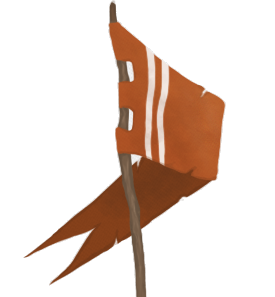The collapse of our civilisation is no excuse to turn on our own people and to embrace the barbaric ways of our neighbours. Ahelaldi was established to defend our ways of life from the savages of the north, and we shall continue to do so until the last of us have drawn our final breath!— Bilafir Olgab, Vaja of Ahelaldi, 283 AU
Ahelaldi is a march located in the barren wastes of
Bratayya. It was established by the
Rahyamin Empire in 194 AU to serve as a buffer between the provinces they had conquered in
Pekkola and the empire's core heartlands. When
civil war broke out between the five claimants who had all declared themselves
Bahal, the
Vaja of Ahelaldi declared that his march would remain neutral and continue to serve the purpose it was established to do. As it had become clear that the empire had fallen, the Vaja swore to continue their task and to bring back the light of civilisation by finding a legitimate heir to the empty throne.
Government
The march of Ahelaldi is governed by a council of twenty elected men and woman who are led by a Vaja who has full control over military matters. All other decisions require the approval of the majority of the council. A Vaja must be elected by thirteen of the twenty councillors in an election, and they keep the position for life or until they wish to retire.
Imperial Law
While lawlessness ravaged the rest of the world, Ahelaldi stayed faithful to the old Imperial law. To this day, whenever a Vaja or councillor is elected, they swear fealty to the Bahal even though they don't know who they are pledging themselves to or whether they still exist.
The adamant stance to stick to the old ways resulted in an influx of people who sought to move to Ahelaldi to enjoy the benefits of their peace and order. Such additional folk were of great use in bolstering the garrisons, and they helped shore up defences.
Military
The Vajas of Ahelaldi have always taken their people's security seriously. Over the years, they have built up a vast fortress in Shla ai-Doai, constructed earthworks that stretch between the
Gaps of Morai, and they have established several outposts to defend their merchants. Military exercises are done annually to drill the civilian workforce and to make sure they are ready for whatever wishes to threaten their lives and homes.
Military Equipment
An infantryman who has volunteered to serve in the army is given a free set of mail, two javelins, an oval-shaped centre-gripped shield, a sword designed to pierce mail, and a sturdy helmet.
Adventurous and daring men make up the bulk of their standing army. Even while at peace, these bands go out to raid nearby factions to teach them a lesson and to pillage their goods.
These men are also essential for protecting trade routes and countering hostile raiders before they could take out shipments of food headed toward the Ahelaldiri.
Economy
Ahelaldi is located in between the Gaps of Morai, two massive crevasses which contain vast amounts of iron, tin, and precious gemstones. The locals have had to construct mines on the inner walls of these cracks to harvest its riches. The wealth that they extract from there allows them to import food, fabrics and livestock, which are all crucial for their survival.
The arid and barren wasted that surround the gaps are unsuitable for nearly all plants. Only a few shrubs and gnarly trees have made the wasteland their home.









Love this layout, and your timeline, Dhelian? Georgous.
Storyteller, Cartoonist,..pretty awesome friend =)
Subscribe to Life of Fiction to see the live results of all this worldbuilding.